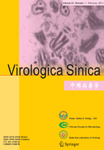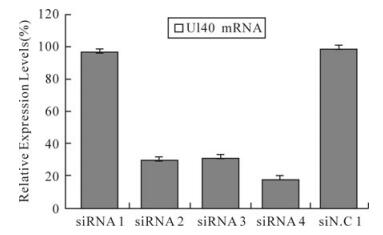-
Andino R. 2003. RNAi puts a lid on virus replication. Nat Biotechnol, 21: 629-630.
doi: 10.1038/nbt0603-629
-
Bhuyan P K, Kariko K, Capodici J. 2004. Short interfering RNA-mediated inhibition of herpes simplex virus type 1 gene expression and function during infection of human keratinocytes. J Virol, 78: 10276-10281.
doi: 10.1128/JVI.78.19.10276-10281.2004
-
Brandt C R, Kintner R L, Pumfrey A M, et al. 1991. The herpes simplex virus ribonucleotide reductase is required for ocular virulence. J Gen Virol, 72: 2043-2049.
doi: 10.1099/0022-1317-72-9-2043
-
Cameron J M, Mcdougall I, Marsden H S, et al. 1988. Ribonucleotide reductase encoded by herpes simplex virus is a determinant of the pathogenicity of the virus in mice and a valid antiviral target. J Gen Virol, 69: 2607-2612.
doi: 10.1099/0022-1317-69-10-2607
-
Cory J G. 1988. Ribonucleotide reductase as a chemotherapeutic target. Adv Enzyme Regul, 27: 437-455.
doi: 10.1016/0065-2571(88)90030-1
-
David J G, Sandra K W. 1988. Herpes Simplex Virus Type 1-Induced Ribonucleotide Reductase Activity Is Dispensable for Virus Growth and DNA Synthesis: Isolation and Characterization of an ICP6 lacZ Insertion Mutant. J Virol, 62: 196-205.
-
Elbashir S M, Harborth J, Weber K, et al. 2002. Analysis of gene function in somatic mammalian cells using small interfering RNAs. Methods, 26: 199-213.
doi: 10.1016/S1046-2023(02)00023-3
-
Frame M C, Marsden H S, Dutia B M. 1985. The ribonucleotide reductase induced by herpes simplex virus type 1 involves minimally a complex of two polypeptides (136K and 38K). J Gen Virol, 66: 1581-1587.
doi: 10.1099/0022-1317-66-7-1581
-
Honess R.W, Roizman B. 1973. Proteins specified by herpes simplex virus. XI. Identification and relative molar rates of synthesis of structural and non-structural herpes virus polypeptides in infected cells. J Virol, 12: 1347-1365.
-
Honess R W, Roizman B. 1974. Regulation of herpes virus macromolecular synthesis.Ⅰ. Cascade regulation of the synthesis of three groups of viral proteins. J Virol. 14:8-19.
-
Holen T, Amarzguioui M, Wiiger M T, et al. 2002. Positional effects of short interfering RNAs targeting the human coagulation trigger Tissue Factor. Nucleic Acids Res, 30: 1757-1766.
doi: 10.1093/nar/30.8.1757
-
Idowu A D, Fraser-Smith E B, Poffenberger K L, et al. 1992. Deletion of the herpes simplex virus type 1 ribonucleotide reductase gene alters virulence and latency in vivo. Antiviral Res, 17: 145-156.
-
Ingemarson R, Lankinen H. 1987. The herpes simplex virus type 1 ribonucleotide reductase is a tight complex of the type alpha 2 beta 2 composed of 40K and 140K proteins, of which the latter shows multiple forms due to proteolysis. Virology, 156: 417-422.
doi: 10.1016/0042-6822(87)90422-3
-
Jacobson J G, Leib A D, Goldstein D J, et al. 1989. A herpes simplex virus ribonucleotide reductase deletion mutant is defective for productive acute and reactivatable latent infections of mice and for replication in mouse cells. Virology, 173: 276-283.
doi: 10.1016/0042-6822(89)90244-4
-
Jiang M, Milner J. 2002. Selective silencing of viral gene expression in HPV-positive human cervical carcinoma cells treated with siRNA, a primer of RNA interference. Oncogene, 21: 6041-6048.
doi: 10.1038/sj.onc.1205878
-
Kawasaki H, Suyama E, Iyo M, et al 2003. siRNAs generated by recombinant human Dicer induce specific and significant but target site-independent gene silencing in human cells. Nucl Acids Res, 31: 981-987.
doi: 10.1093/nar/gkg184
-
Khvorova A, Reynolds A, Jayasena S D. 2003. Functional siRNAs and rniRNAs exhibit strand bias. Cell, 115: 209-216.
doi: 10.1016/S0092-8674(03)00801-8
-
Livak K J, Schmittgen T D. 2001. Analysis of relative gene expression data using real-time quantitative PCR and the 2(-ΔΔCT). Methods, 25: 402-408.
doi: 10.1006/meth.2001.1262
-
Luo K Q, Chang D C. 2004. The gene-silencing efficiency of siRNA is strongly dependent on the local structure of mRNA at the targeted region. Biochem Biophys Res Commun, 318: 303-310.
doi: 10.1016/j.bbrc.2004.04.027
-
Mcgeoch D J, Dalrymple M A, Davison A J, et al. 1988. The complete DNA sequences of the long unique region in the genome of herpes simplex virus type 1. J Gen Virol, 69: 1531-1574.
doi: 10.1099/0022-1317-69-7-1531
-
Preston V G, Coates J A, Rixon F J. 1983. Identification and characterization of a herpes simplex virus gene product required for encapsidation of virus DNA. J Virol, 45: 1056-1064.
-
Preston V G, Palfreyman J W, Dutia B M. 1984. Identification of a herpes simplex virus type 1 polypeptide which is a component of the virus-induced ribonucleotide reductase. J Gen Virol, 65: 1457-1466
doi: 10.1099/0022-1317-65-9-1457
-
Pu Y, Liu L D, Ma S H. 2005. Analysis of siRNA interfering in the alpha 22 immediate early gene of HSV-1. Virol Sin, 20: 221-224.
-
Ren Z, Zhang M Y, Kitazato K, et al. 2008. Effect of siRNA on HSV-1 plaque formation and relative expression levels of UL39 mRNA. Arch Virol. 153: 1401-1406.
doi: 10.1007/s00705-008-0110-1
-
Ren Z, Zhang C H, Wang L J, et al. 2010. In Vitro Anti-viral Activity of the Total Alkaloids from Tripterygium Hypoglaucum against Herpes Simplex Virus Type 1. Virol Sin, 25: 107-114.
doi: 10.1007/s12250-010-3092-6
-
Robins M J. 1999. Mechanism-based inhibition of ribonucleotide reductases: new mechanistic considerations and promising biological applications. Nucleosides Nucleotides, 18: 779-793.
doi: 10.1080/15257779908041565
-
Schubert S, Grunweller A, Erdmann V A, et al 2005. Local RNA target structure influences siRNA efficacy: systematic analysis of intentionally designed binding regions. J Mol Bio, 348: 883-893.
doi: 10.1016/j.jmb.2005.03.011
-
Song E, Lee S K, Wang J, et al. 2003. RNA interference targeting Fas protects mice from fulminant hepatitis. Nat Med, 9: 347-351.
doi: 10.1038/nm828
-
Szekeres T, Fritzer-Szekeres M, Elford H L. 1997. The enzyme ribonucleotide reductase: target for antitumor and anti-HIV therapy. Crit Rev Clin Lab Sci, 34: 503-528.
doi: 10.3109/10408369709006424
-
Thelander L, Reichard P. 1979. Reduction of ribonucleotides. Annu Rev Biochem, 48:133-158.
doi: 10.1146/annurev.bi.48.070179.001025
-
Vickers T A, Koo S, Bennett C F, et al 2003. Efficient reduction of target RNAs by small interfering RNA and RNase H-dependent antisense agents. A comparative analysis. J Biol Chem, 278: 7108-7118.
doi: 10.1074/jbc.M210326200
-
Yamada Y, Kimura H, Morishima T, et al. 1991. The pathogenicity of ribonucleotide reductase-null mutants of herpes simplex virus type 1 in mice. J Infect Dis, 164: 1091-1097.
doi: 10.1093/infdis/164.6.1091
-
Zhu Q C, Ren Z, Zhang C L et al. 2007. Silencing HSV-1 gD expression in cultured cells by RNA interference. Chin J Virol, 23: 22-27.












